


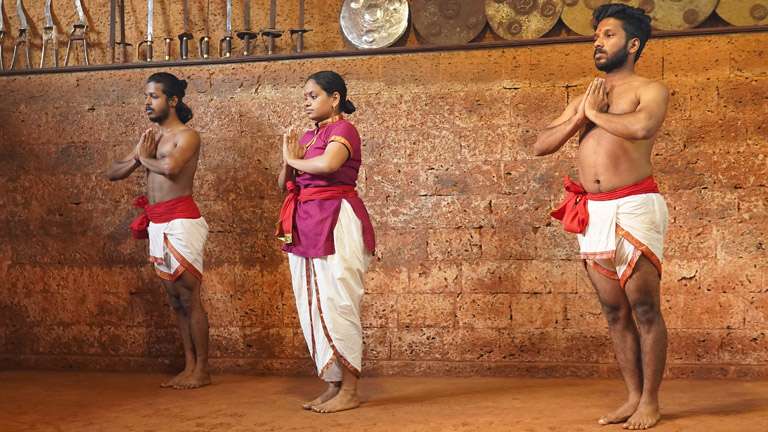
Marmashastra or the science of Marmas is part of Shalyatantra, one of the eight categories into which Ayurveda is divided. Ancient masters like Sushruta and Sage Agastya have written in detail about Marmashastra. This science has a very significant role to play in Kalaripayattu training and is taught alongside Verumkai prayogam or unarmed combat after the students have been sufficiently coached in Angathari or armed combat. It is after the student has been trained in fighting with all forms of weapons, that he/she is initiated into the moves and stances of unarmed combat. When Marmavidya or knowledge of the marmas is taught, the asan insists that it should be used only as of the last option for defeating the opponent. Marmas in Human body The marmas of the body are not visible on the outside. They lie deep within. There are 108 marmas in the human body, which have been divided into two categories. They are thodu marmas (96 in number) and padu marmas (12). There are 25 marmas above the neck, 45 between the neck and the navel, 9 between the navel and the moolaadhara [primary focal point of the subtle human body], 14 in each arm and 15 in each leg. This is according to the southern tradition of Kalaripayattu. The northern tradition of Kalaripayattu puts the number of marmas at 107, of which 64 are described as abhyaasa marmas. All the marmas have been given distinct names, and the consequences of any damage to each of the marmas have been documented in great detail in several books written by the great masters. It is not unusual for the students to sustain injuries during training, either caused by hands and legs or by weapons. What is important in such situations is timely and correct treatment. Hence, training in Marmachikitsa can be considered to be as important as training in all combat moves and stances. This includes techniques like Uzhichil, Pizhichil, Shirodhara, Kadivasti, Urovasti and so on. All the available literature on Marmachikitsa are unanimous in stating one point. Only those students who are disciplined and have good control over their minds should be trained in the potentially dangerous forms of marma treatment. Besides this is the diktat that inflicting damage on the marmas of the opponent in order to defeat him/her should be considered only in a life-threatening situation. Therefore, even when students are trained in attacking the marmas, they are also taught how to neutralize the effects of the damage.
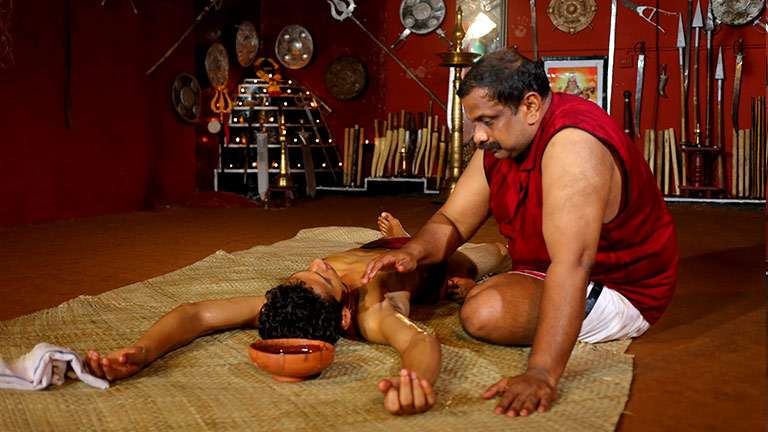
Even today, Marma vidya and Marma chikitsa are part of Kalaripayattu training. In fact, Kalari chikitsa boasts of many a traditional panacea that is not very popularly used in Ayurvedic treatment. Stroking and caressing serve not only to show affection but help relieve pain as well. This feature of behaviour is found in animals too. The cow licking its calf is an expression of love. Equally, by the process of gently caressing, veins and arteries can be rejuvenated, and thereby pain lessened. An awareness of this physiological peculiarity was what caused the evolution of Uzhichil as a scientifically developed treatment procedure. Charaka, Sushruta and Vagbhata emphasize the importance of Uzhichil and Pizhichil. Oil massage is known to improve blood circulation. Uzhichil is also helpful in removing oedema in various cells, reducing obesity and improving digestion.

Thaila lepanam is the application of oil all over the body before the student begins the exercise regimen, and this is an integral part of Kalaripayattu training. Sesame oil is generally used for the purpose. Occasionally, however, certain other oils that are more conducive to the physical peculiarity of the student are also chosen. Application of oil imparts flexibility to the body, reduces obesity and gives strength to the muscles. Usually, the students do the oil application on their own.
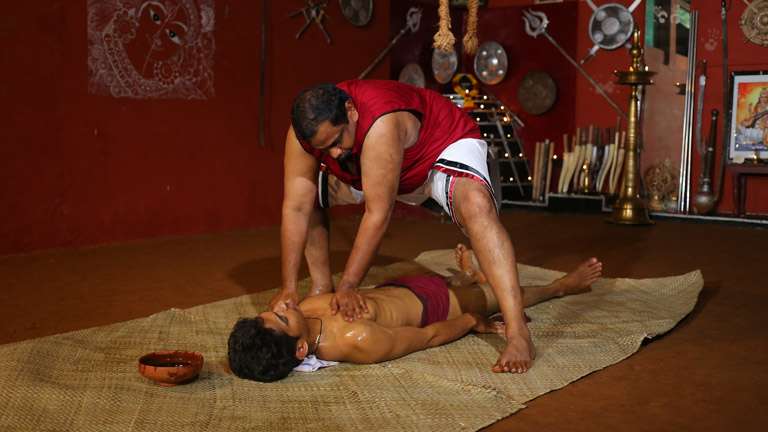
Kalari chikitsa follows the same principles of Uzhichil as propounded by Ayurveda. The mode of treatment is decided upon after taking into consideration the physical condition of the person concerned. Traditional texts recommend moderate uzhichil for individuals whose physiology shows a dominant vata quality, very mild uzhichil for those with pitta and rigorous uzhichil for those with kapha. Old people and children are not subjected to massage at all. If a patient is involved, the most appropriate herbal oil or other oils are chosen after the diagnosis is finalized.
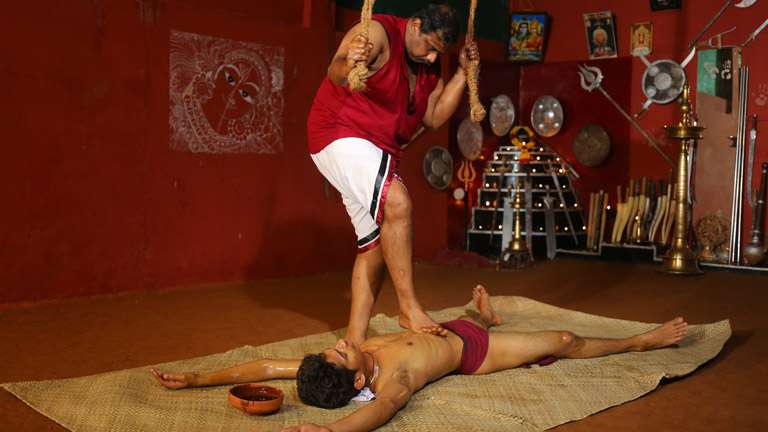
The senior students of Kalaripayattu are subjected to Chavitti uzhichil. It takes a very experienced asan to do it. He balances himself by holding a rope that is tied horizontally across the room above his head and uses his legs to massage the student’s body. He has very clear awareness about how much pressure he must apply to various parts. The neck, face, and head are massaged only using the hands.
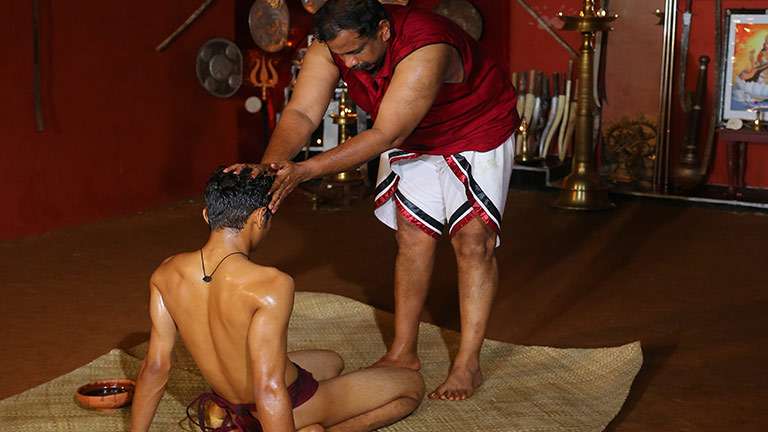
Most of the medicines used in Kalari chikitsa are not those mentioned in Ayurvedic texts. For instance, Murivenna is used copiously in Kalari chikitsa, a medicated oil that is not mentioned in Ayurveda. Usually Murivenna is concocted using betel and murikku (Indian coral tree/Erythrina variegata) leaves, although different Kalari asans exercise their own preferences according to the texts they consult. Injuries sustained during exercises or training needs immediate treatment. The asans are adept at choosing the right treatment protocol. Their skill set includes scholarship in Marmashastra, experience in Uzhichil, dexterity in fixing dislocations of bones and so on.
Department of Tourism, Government of Kerala, Park View, Thiruvananthapuram, Kerala, India - 695 033
Phone: +91 471 2321132, Fax: +91 471 2322279, E-mail: info@keralatourism.org.
All rights reserved © Kerala Tourism 2025. Copyright | Terms of Use | Cookie Policy | Contact Us. Developed & Maintained by Invis.